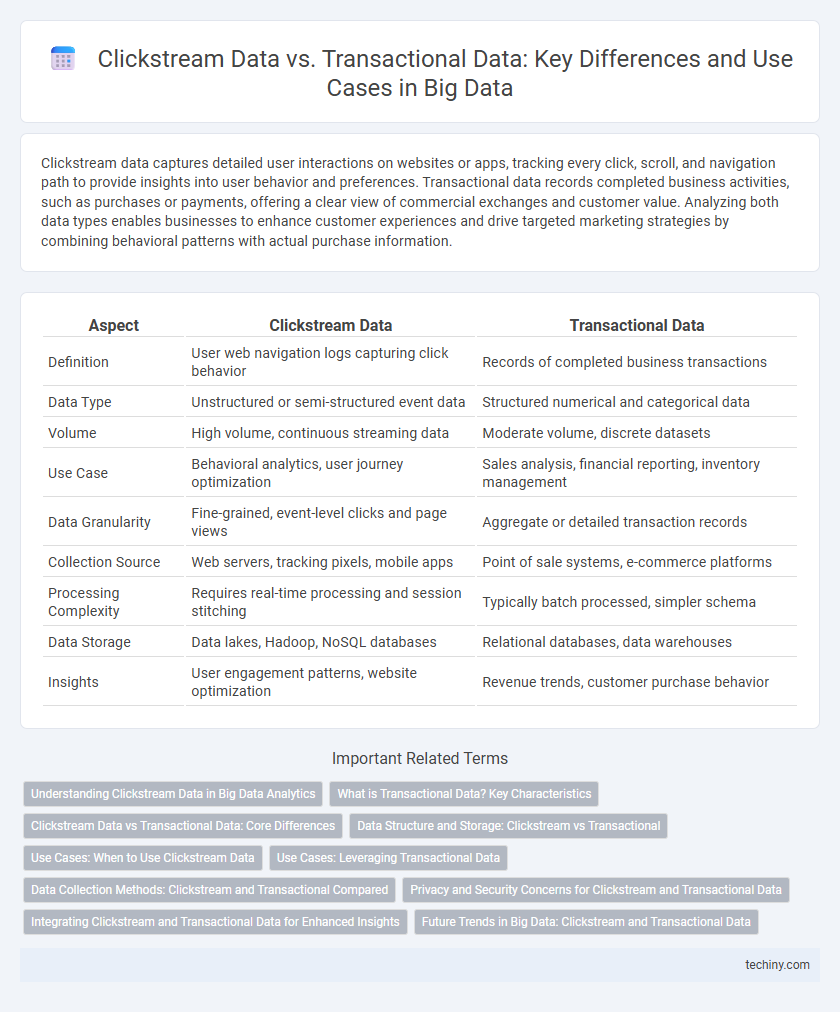Clickstream data captures detailed user interactions on websites or apps, tracking every click, scroll, and navigation path to provide insights into user behavior and preferences. Transactional data records completed business activities, such as purchases or payments, offering a clear view of commercial exchanges and customer value. Analyzing both data types enables businesses to enhance customer experiences and drive targeted marketing strategies by combining behavioral patterns with actual purchase information.
Table of Comparison
| Aspect | Clickstream Data | Transactional Data |
|---|---|---|
| Definition | User web navigation logs capturing click behavior | Records of completed business transactions |
| Data Type | Unstructured or semi-structured event data | Structured numerical and categorical data |
| Volume | High volume, continuous streaming data | Moderate volume, discrete datasets |
| Use Case | Behavioral analytics, user journey optimization | Sales analysis, financial reporting, inventory management |
| Data Granularity | Fine-grained, event-level clicks and page views | Aggregate or detailed transaction records |
| Collection Source | Web servers, tracking pixels, mobile apps | Point of sale systems, e-commerce platforms |
| Processing Complexity | Requires real-time processing and session stitching | Typically batch processed, simpler schema |
| Data Storage | Data lakes, Hadoop, NoSQL databases | Relational databases, data warehouses |
| Insights | User engagement patterns, website optimization | Revenue trends, customer purchase behavior |
Understanding Clickstream Data in Big Data Analytics
Clickstream data captures users' online behavior by recording their sequence of clicks, page views, and interactions in real time, providing detailed insights into customer journeys and website performance. In big data analytics, this granular behavioral data helps identify patterns, optimize user experience, and enhance targeted marketing strategies by analyzing massive volumes of unstructured data. Understanding clickstream data is crucial for businesses aiming to leverage predictive analytics and improve conversion rates through personalized digital engagement.
What is Transactional Data? Key Characteristics
Transactional data captures detailed records of individual business transactions, such as sales, payments, or bookings, including time, amount, and parties involved. Key characteristics include high granularity, time-stamped entries, and structured formats ideal for tracking changes in customer behavior and operational processes. This data supports real-time analytics, fraud detection, and financial reconciliation in business intelligence systems.
Clickstream Data vs Transactional Data: Core Differences
Clickstream data captures user interactions on websites, recording page views, clicks, and navigation paths in real-time, while transactional data documents completed business activities such as purchases, payments, and order details. Clickstream data is unstructured and event-driven, providing insights into user behavior and engagement patterns, whereas transactional data is structured and focused on financial or operational accuracy. The core difference lies in clickstream data's role in behavioral analysis versus transactional data's function in business record-keeping and financial reporting.
Data Structure and Storage: Clickstream vs Transactional
Clickstream data is unstructured or semi-structured, capturing user behavior logs from website interactions, often stored in distributed file systems like Hadoop for scalability. Transactional data is highly structured, reflecting discrete business events stored in relational databases optimized for ACID compliance and fast query performance. Storage solutions for clickstream data prioritize flexibility and volume handling, while transactional data storage emphasizes data integrity and real-time processing.
Use Cases: When to Use Clickstream Data
Clickstream data is essential for optimizing website user experience by tracking real-time navigation paths, identifying drop-off points, and personalizing content based on user behavior. E-commerce platforms leverage clickstream data to analyze customer browsing patterns, enabling targeted marketing campaigns and improving product recommendations. This data type is invaluable for A/B testing, conversion rate optimization, and enhancing customer engagement through detailed insights into visitor interactions.
Use Cases: Leveraging Transactional Data
Transactional data enables businesses to analyze purchase histories, track customer behavior, and optimize inventory management by capturing detailed records of sales, payments, and order statuses. Retailers and e-commerce platforms leverage transactional data to personalize marketing campaigns, improve customer segmentation, and enhance fraud detection systems. Financial institutions use transactional data for real-time risk assessment, credit scoring, and regulatory compliance reporting.
Data Collection Methods: Clickstream and Transactional Compared
Clickstream data is captured through tracking user interactions on websites or applications using cookies, tracking pixels, and server logs, enabling real-time collection of browsing behavior and navigation patterns. Transactional data, on the other hand, is gathered from point-of-sale systems, e-commerce platforms, and financial records, recording detailed information about purchases, payments, and exchanges. Both data types utilize distinct collection technologies: clickstream relies heavily on web analytics tools, while transactional data is often collected through structured database systems that ensure accuracy and compliance.
Privacy and Security Concerns for Clickstream and Transactional Data
Clickstream data, which records users' online behavior in real time, poses significant privacy risks due to its detailed tracking of individual actions and potential for user identification. Transactional data includes sensitive financial and personal information, requiring stringent security measures like encryption and access controls to prevent fraud and data breaches. Both data types necessitate compliance with regulations such as GDPR and CCPA to safeguard user privacy and ensure secure data handling.
Integrating Clickstream and Transactional Data for Enhanced Insights
Integrating clickstream data with transactional data enables businesses to gain comprehensive insights by combining user behavior patterns with actual purchase information. This fusion allows for deeper customer journey analysis, improved personalization, and more accurate attribution modeling. Leveraging both data types enhances predictive analytics and drives more informed marketing strategies.
Future Trends in Big Data: Clickstream and Transactional Data
Emerging trends in big data emphasize the integration of clickstream data and transactional data to create comprehensive customer profiles and predictive analytics. Advanced machine learning algorithms are increasingly applied to clickstream data for real-time behavioral insights, while transactional data continues to drive precise revenue forecasting and inventory management. The convergence of these data types enables enhanced personalization in marketing strategies and optimized decision-making processes across industries.
Clickstream Data vs Transactional Data Infographic

 techiny.com
techiny.com